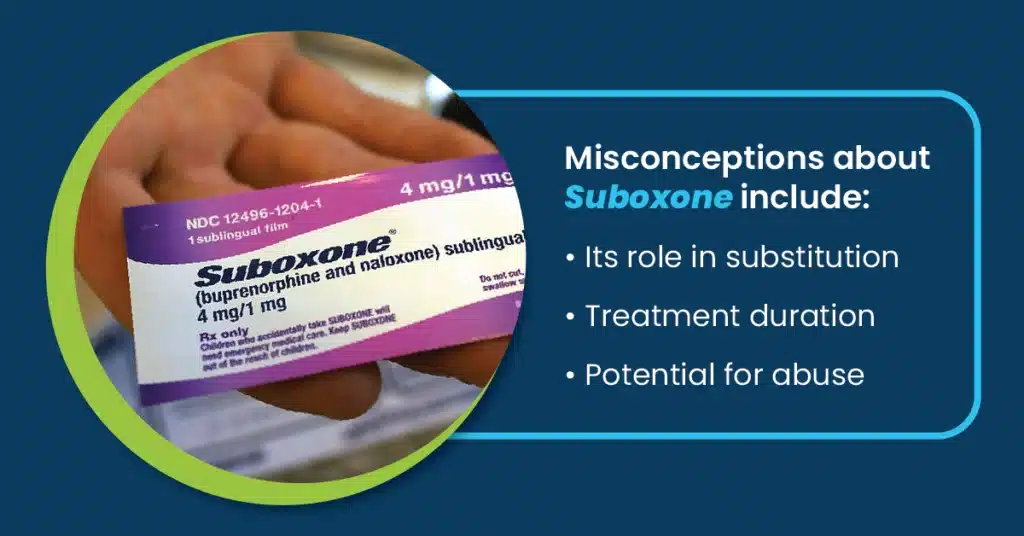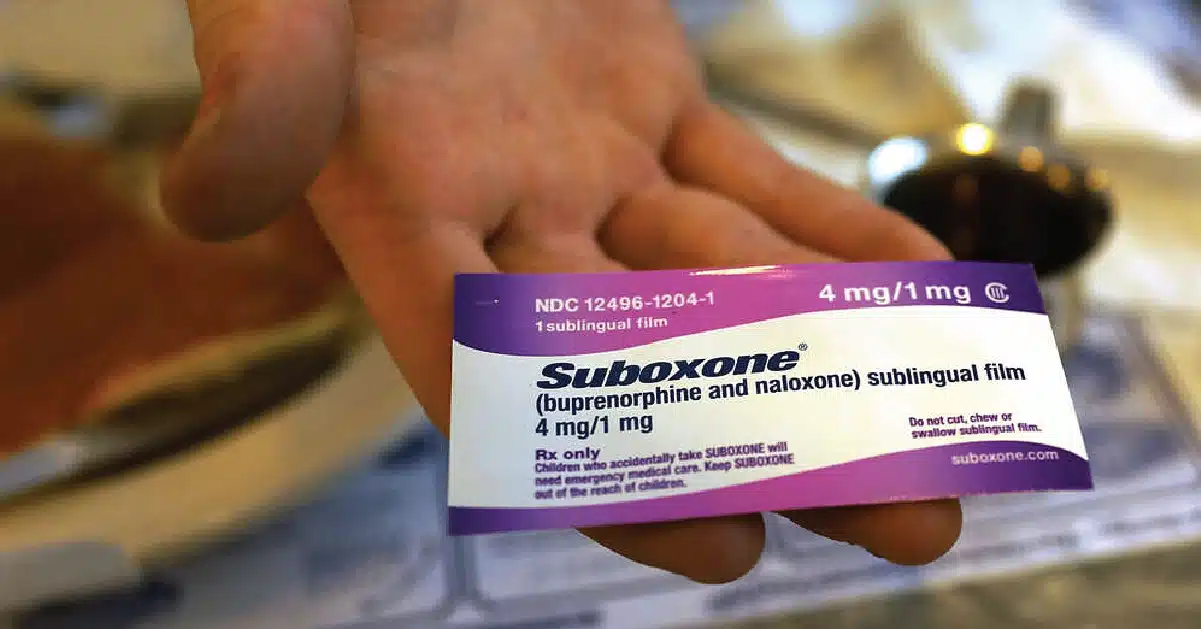Suboxone helps treat opioid use disorders by interacting with opioid receptors in the brain. It contains opioid agonists and antagonists—these active ingredients aid addiction recovery by easing the process and minimizing cravings, fostering a smoother journey.
It also blocks the effects of other opioids, enhancing the effectiveness of the treatment. Suboxone is part of a holistic approach to address substance use disorders. It offers a secure path towards recovery by stabilizing brain function and reducing the impact of addictive drugs.
Key Takeaways
Suboxone aids opioid addiction recovery by easing withdrawal, reducing cravings, and blocking other opioids’ effects. Here’s what you need to know:
- Suboxone’s buprenorphine and naloxone combo improved opioid addiction treatment methods.
- Suboxone’s dual-action approach lessens opioid risks, curbing opioid overdose and health consequences tied to misuse.
- Misconceptions about Suboxone include its role in substitution, treatment duration, and potential for abuse.
- It does have a potential for abuse and requires medical advice for safer use.
Don’t fight the battle against addiction alone when The Haven Detox-South Florida is here to assist you. Call us at (561) 328-8627 today.
Historical Background of Suboxone
Suboxone, developed in the early 2000s, emerged as a crucial tool in treating opioid addiction. The main components, buprenorphine, and naloxone, were combined to create a drug that reduces the urge to misuse illicit opioids.
Buprenorphine, a partial opioid agonist, provides relief without causing a euphoric effect that usually happens when you consume other opioids. Naloxone, an opioid antagonist, deters the risk of misuse by inducing unpleasant withdrawal symptoms. This combination makes Suboxone an essential part of medication-assisted treatment (MAT) therapy for opioid use disorders.
Approved by the Food and Drug Administration (FDA), Suboxone has become widely used in addiction treatment programs. It offers a suitable path to recovery for individuals grappling with opioid dependencies. Its debut marked a crucial stride in battling the opioid epidemic, offering a safer approach to conquering addiction.
How Suboxone Works and Blocks Opioid Effects
During medication-assisted treatment, doctors prescribe Suboxone for opioid use disorders because its working mechanism improves the chance of recovery. Its mechanism of action lies in the synergistic effects of its two primary components: buprenorphine and naloxone.
Buprenorphine
Buprenorphine, a partial opioid agonist, binds to the same receptors in the brain that opioids latch onto but does so more gently. This partial activation eases withdrawal symptoms such as body aches, vomiting, and nausea.
Moreover, it lowers the risk of relapse, providing a controlled and steady pathway to recovery. By occupying these receptors, buprenorphine effectively reduces the desire for stronger opioids without inducing intense euphoria.
Naloxone
Naloxone, on the other hand, serves as an opioid antagonist. If someone attempts to misuse Suboxone by injecting it, naloxone becomes active, blocking opioid receptors and precipitating withdrawal symptoms. That discourages inappropriate use and reinforces the medication’s role as a therapeutic aid rather than a substance of abuse.
Together, these dual actions make Suboxone a valuable tool in helping individuals overcome the challenges of opioid addiction.
Medical Uses of Suboxone
In the United States, you can only get Suboxone if a doctor prescribes it. That shows how important it is to control who gets it. Doctors decide how much someone needs based on their specific situation, ensuring it’s used responsibly.
Aiding Opioid Addiction Recovery
Suboxone, functioning as a partial agonist, is instrumental in medication-assisted treatment (MAT) for individuals dealing with opioid addiction. Healthcare providers incorporate it into treatment plans to help manage a patient’s well-being.
Individuals who stop the use of opioids are likely to experience physical and mental distress. Suboxone reduces discomfort and fosters a safe pathway toward sustained recovery. With a ceiling effect, Suboxone provides a safer, long-term solution compared to stronger alternatives like methadone.
Alleviating Chronic Pain
Beyond its role in addiction treatment, Suboxone finds application in addressing chronic pain. Healthcare providers may prescribe Suboxone as an alternative to traditional opioid medications, offering relief while minimizing the risk of dependence. This dual-purpose use underscores Suboxone’s versatility in pain management within a controlled framework.
Maintenance Therapy
Suboxone, an FDA-approved medication, serves as a lasting aid for those with opioid use disorder, acting as a maintenance medication to foster prolonged recovery. That proves especially advantageous for individuals with a history of relapse or those requiring continual support to sustain abstinence.
Reduction of Opioid-Related Risks
Suboxone lessens opioid risks by maintaining a steady level of opioids via its buprenorphine component. That diminishes the risk of overdose, curbs infectious diseases linked to opioid injection (like HIV or hepatitis), and mitigates various health and social consequences tied to opioid misuse.
Potential Side Effects and Risks of Suboxone
Suboxone helps with opioid addiction, but it can have side effects and risks. It’s important to know these for wise choices.
Common Suboxone Side Effects
While Suboxone aids recovery, individuals may experience common side effects. These can include nausea, headaches, and constipation.
Although these effects are generally mild and temporary, their prevalence highlights the importance of close monitoring during the initial phases of Suboxone treatment. Recognizing and managing these side effects is vital to enhance the overall well-being of individuals on this medication.
Risks and Safety Concerns in Using Suboxone
Despite its efficacy, Suboxone use is not devoid of risks. Potential respiratory depression, allergic reactions, and drug abuse pose serious concerns.
Additionally, combining Suboxone with certain medications or substances may lead to adverse interactions. Understanding and mitigating these risks requires vigilant medical supervision and a collaborative approach between healthcare providers and individuals seeking recovery.
Debunking Myths About Suboxone

Suboxone is a medication commonly used in the treatment of opioid addiction. However, there are some misconceptions surrounding Suboxone.
Misconception: Suboxone Can Lead to Another Addiction
Suboxone contains buprenorphine that is used in addiction treatment. The second ingredient is naloxone, an opioid antagonist. It’s considered a harm reduction strategy rather than simply substituting one addiction for another. It helps manage cravings and withdrawal symptoms without producing the intense euphoria associated with full opioids.
Misconception: Suboxone Treatment is a Lifelong Commitment
In reality, Suboxone treatment duration varies for each individual. While some may require long-term maintenance, others may use it for a shorter period to manage withdrawal symptoms during detox. The decision to discontinue Suboxone is typically made in consultation with healthcare providers based on the patient’s progress.
Misconception: Using Suboxone is Not a Proper Treatment
Medication-assisted treatment (MAT), including Suboxone, is recognized as a valid and effective approach along with behavioral therapy during opioid addiction recovery. It can stabilize individuals, allowing them to engage in counseling and make lifestyle changes. Recovery is a complex process, and MAT is one tool that can be used to support it.
Misconception: Suboxone is easily abused or diverted
While diversion can occur, the combination of buprenorphine and naloxone is designed to lower the risk of misuse. If Suboxone is taken as prescribed, the naloxone component remains inactive. If crushed and injected, the naloxone becomes active, leading to withdrawal symptoms. Proper monitoring and adherence to prescribing guidelines help minimize the risk of diversion.
Potential for Abuse
While Suboxone is intended for opioid addiction recovery, it can still be misused. Individuals with prescription drugs may exceed recommended doses to achieve an opiate high. Recreational abuse occurs when people obtain Suboxone from friends or dealers.
Misusing for Comfort
Some individuals may be at risk of using Suboxone without a genuine need for opioid dependence treatment. This misuse can lead to adverse effects and is a concern for healthcare providers in ensuring that the medication is prescribed and used appropriately.
Tolerance and Dependence
Prolonged use of Suboxone can lead to the development of tolerance and physical dependence. While it is a partial opioid agonist with a lower potential for abuse than full agonists, some individuals may still experience a level of dependence. Proper medical supervision and adherence to prescribed dosages are crucial to mitigate this risk.
Frequently Asked Questions
What is Suboxone?
Suboxone, crafted for treating opioid dependence, combines buprenorphine to alleviate withdrawal and cravings and naloxone to deter misuse by triggering withdrawal if injected. It’s a dual-action medication aiming for effective recovery support.
What happens when you first start taking Suboxone?
Starting Suboxone brings relief from opioid withdrawal. Buprenorphine’s partial agonist action stabilizes receptors, curbing cravings without intense euphoria. Naloxone, dormant when taken correctly, activates if misused through injection, deterring improper usage.
Why does Suboxone block opiates?
Suboxone’s buprenorphine component binds to opioid receptors in the brain, providing a controlled and sustained activation. As a partial agonist, it occupies these receptors without inducing the maximal effects seen with full agonists like heroin or oxycodone.
Discover a Renewed Life at The Haven Detox-South Florida
Addiction is a vicious cycle that requires a suitable plan to break free. The Haven Detox-South Florida not only understands the complexity of this illness but crafts treatment plans to fit your needs.
Our medical detox offers counseling and medication treatment to help your body adjust to the absence of drugs. At our residential rehab, we offer substance addiction treatment, such as opioids, in a home-like setting. We aim to provide comfort while your body heals and finds peace in a drug-free life.Don’t hesitate to call us at (561) 328-8627 and talk to our helpful team of medical experts.

